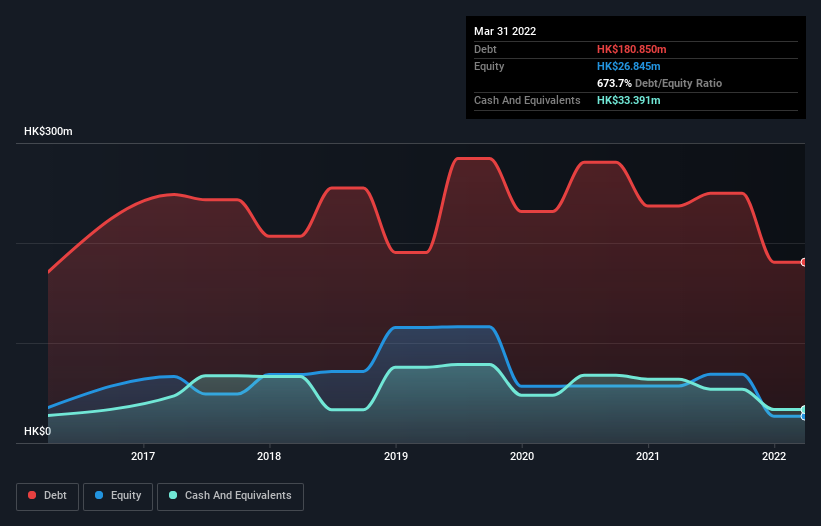The external fund manager backed by Berkshire Hathaway's Charlie Munger, Li Lu, makes no bones about it when he says 'The biggest investment risk is not the volatility of prices, but whether you will suffer a permanent loss of capital.' So it seems the smart money knows that debt - which is usually involved in bankruptcies - is a very important factor, when you assess how risky a company is. As with many other companies Sterling Group Holdings Limited (HKG:1825) makes use of debt. But the more important question is: how much risk is that debt creating?
When Is Debt Dangerous?
Debt assists a business until the business has trouble paying it off, either with new capital or with free cash flow. In the worst case scenario, a company can go bankrupt if it cannot pay its creditors. While that is not too common, we often do see indebted companies permanently diluting shareholders because lenders force them to raise capital at a distressed price. Of course, plenty of companies use debt to fund growth, without any negative consequences. When we examine debt levels, we first consider both cash and debt levels, together.
Check out our latest analysis for Sterling Group Holdings
How Much Debt Does Sterling Group Holdings Carry?
The image below, which you can click on for greater detail, shows that Sterling Group Holdings had debt of HK$180.9m at the end of March 2022, a reduction from HK$237.1m over a year. However, because it has a cash reserve of HK$33.4m, its net debt is less, at about HK$147.5m.

How Strong Is Sterling Group Holdings' Balance Sheet?
The latest balance sheet data shows that Sterling Group Holdings had liabilities of HK$268.4m due within a year, and liabilities of HK$29.0m falling due after that. Offsetting this, it had HK$33.4m in cash and HK$125.0m in receivables that were due within 12 months. So its liabilities total HK$139.0m more than the combination of its cash and short-term receivables.
This deficit casts a shadow over the HK$26.8m company, like a colossus towering over mere mortals. So we'd watch its balance sheet closely, without a doubt. After all, Sterling Group Holdings would likely require a major re-capitalisation if it had to pay its creditors today. The balance sheet is clearly the area to focus on when you are analysing debt. But you can't view debt in total isolation; since Sterling Group Holdings will need earnings to service that debt. So if you're keen to discover more about its earnings, it might be worth checking out this graph of its long term earnings trend.
In the last year Sterling Group Holdings wasn't profitable at an EBIT level, but managed to grow its revenue by 23%, to HK$456m. Shareholders probably have their fingers crossed that it can grow its way to profits.
Caveat Emptor
Even though Sterling Group Holdings managed to grow its top line quite deftly, the cold hard truth is that it is losing money on the EBIT line. Its EBIT loss was a whopping HK$47m. If you consider the significant liabilities mentioned above, we are extremely wary of this investment. That said, it is possible that the company will turn its fortunes around. Nevertheless, we would not bet on it given that it lost HK$39m in just last twelve months, and it doesn't have much by way of liquid assets. So while it's not wise to assume the company will fail, we do think it's risky. When analysing debt levels, the balance sheet is the obvious place to start. However, not all investment risk resides within the balance sheet - far from it. Case in point: We've spotted 2 warning signs for Sterling Group Holdings you should be aware of.
If, after all that, you're more interested in a fast growing company with a rock-solid balance sheet, then check out our list of net cash growth stocks without delay.
New: Manage All Your Stock Portfolios in One Place
We've created the ultimate portfolio companion for stock investors, and it's free.
• Connect an unlimited number of Portfolios and see your total in one currency
• Be alerted to new Warning Signs or Risks via email or mobile
• Track the Fair Value of your stocks
Have feedback on this article? Concerned about the content? Get in touch with us directly. Alternatively, email editorial-team (at) simplywallst.com.
This article by Simply Wall St is general in nature. We provide commentary based on historical data and analyst forecasts only using an unbiased methodology and our articles are not intended to be financial advice. It does not constitute a recommendation to buy or sell any stock, and does not take account of your objectives, or your financial situation. We aim to bring you long-term focused analysis driven by fundamental data. Note that our analysis may not factor in the latest price-sensitive company announcements or qualitative material. Simply Wall St has no position in any stocks mentioned.
About SEHK:1825
Sterling Group Holdings
An investment holding company, manufactures and trades in apparel products in Hong Kong, the United States, and Europe.
Good value with adequate balance sheet.
Market Insights
Community Narratives



